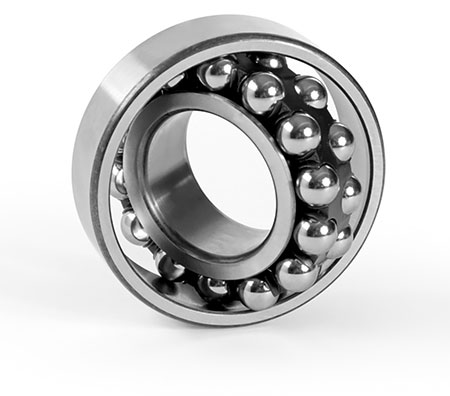
A self-aligning ball bearing is ideal for applications in which the shaft and housing are misaligned. Designed to accommodate a three-degree misalignment, self-aligning ball bearings minimize friction and frictional heat. Due to the relatively small contact angle, axial load capacities of these bearings are lower than, for example, that of angular contact bearings.
The bearings are capable of handling both static and dynamic misalignment. In addition, sealed, self-aligning ball bearings are resistant to dirt and other contaminants. There are many applications for self-aligning ball bearings, including mining, food processing and mass production, such as in the textile industry.
Construction of Self-Aligning Ball Bearings
A self-aligning ball bearing consists of an outer ring, an inner ring, rolling elements, a cage to house the rolling elements and a possible seal that protects the rolling elements and lubricants from contaminants. Their design allows them to compensate for a shaft and housing assembly misalignment up to three degrees. The low friction within the bearing will enable them to operate at higher speeds while generating far less heat than other bearings.
Outer ring
The outer ring of the bearings is smooth and spherical without raceways. As a result of the ring’s shape, the bearing can move slightly within itself, allowing it to adjust to misalignment.
Inner ring
The self-aligning bearing’s inner ring is formed by two raceways holding the balls and cage.
Rolling elements and cage
A cage and an inner ring hold the rolling elements of self-aligning ball bearings in place. Friction and frictional heat are low as there is a loose configuration between the balls and the inner and outer rings. Typically, the cage is made of stamped steel, reinforced glass fiber or machined brass.
Seal
Self-aligning, sealed ball bearings keep dirt and other contaminants from affecting rolling elements and
lubricants. This considerably extends the bearing’s life cycle, eliminates additional friction and reduces maintenance costs and intervals.
Advantages & Disadvantages
Ball bearings with self-aligning characteristics have many advantages over other kinds of bearings like tapered bearings, deep groove ball bearings, etc. However, the load-carrying capacity of self-aligning ball bearings is not as high as that of traditional ball bearings.
Advantages
Misalignment: Self-aligning ball bearings can counteract static and dynamic misalignment of up to
3 degrees.
Service life: These bearings offer high-speed performance and generate less heat and friction than other ball bearing types. This allows them to run cooler and extends their service life while reducing maintenance.
Light load performance: This type of bearing has low load requirements, which means they perform well even under light loads.
Low noise: Self-aligning ball bearings produce low noise levels due to the loose conformity between the rolling elements and the outer ring. This makes them especially suited for household items such as fans.
Disadvantages
Load types: The ball bearings on self-aligning ball bearings are mounted at a relatively straight angle between the inner and outer ring. This makes them suitable for handling radial loads but not axial loads.
Load amount: As self-aligning ball bearings have a small point of axial load-bearing contact, the amount of axial load they can handle is relatively small. If heavy loads are required to be carried, a spherical roller bearing, which has the same self-aligning properties, is recommended.
Self-Aligning Bearing Installation
Adapter sleeves are typically used to mount self-aligning ball bearings.
To properly install these bearings, follow the steps below:
- Package with protective films that prevent outside influences from interacting with the components during transport. Ensure that these films are removed before mounting the bearing.
- Apply oil or grease to the bearing’s exterior surface.
- Use oil to lubricate the adapter.
- Open the adapter slightly and slide it onto the shaft with a spreader tool.
- Place the bearing on the adapter sleeve after the adapter is in the correct position. To bring the bearing to the right place, use a nut if the shaft has threads; if not, use a bearing pusher kit or a small mallet.
- Ensure that the bearing can rotate on the outer ring once it is in place. There should be no swiveling possible, but it should be free to rotate.
- Lock the bearing in place with a locking washer by removing the nut, placing the washer and reinstalling the nut.
Note: The inner ring of the adapter sleeve can start turning if the adapter sleeve is loose or not adequately secured in place. As a result, there may be excessive friction between the three components, damaging the shaft, the adapter and the bearing.
Self-Aligning Bearing Selection Criteria
A self-aligning bearing’s selection is based primarily on the consideration of possible alignment problems but also the application’s rotational speed, load type, load size, tolerances and bearing dimensions.
Misalignment
Bearings with self-aligning abilities are often preferred by necessity. Self-aligning ball bearings are a
great solution when there is a possibility of shaft misalignment. Remember that most self-aligning bearings are only capable of handling misalignments of three degrees or less. Any misalignment above this would need a more customized bearing.
Speed
Compared to conventional bearings, self-aligning bearings can operate at much higher speeds. For high-speed applications, self-aligning bearings are an excellent choice. However, lubrication and bearing size are also factors that affect speed. Therefore, it is also crucial to consider the speed, type of lubrication and load requirements of your machine. The operating pace of grease lubrication is slower than oil lubrication.
Loads
A self-aligning bearing is suited for radial loads but is not suited for axial loads because of its slight contact angle. Be sure to consider this when choosing a bearing.
Seal type and lubrication
A lubrication procedure may be required if the bearing has either an open or shielded seal. Otherwise, a closed seal bearing is typically prelubricated.
Dimensions
Based on the speed requirements, the type of load, the amount of load, the shaft size and the size of the housing, select the bearing size.

